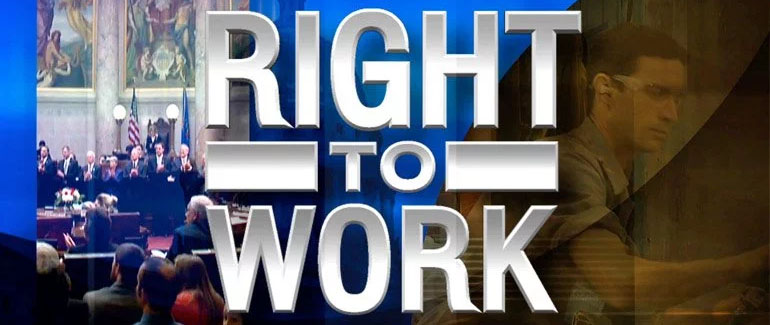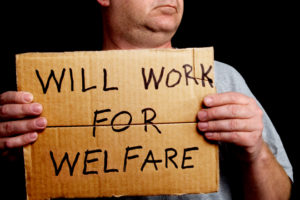Right to Work Program
Wouldn’t it be nice if we could provide jobs for all our unemployed American citizens, and at the same time, help our small businesses grow, lower our taxes, and rebuild the American economy? We can, by simply converting our broken unemployment compensation program to a new “right to work” program.
Here’s how we convert our current broken unemployment (entitlement) program into a new “Right to Work” (volunteer worker) program. 
Step 1
The first step is for our representatives in Congress to announce the termination of our current unemployment compensation program. They will inform everyone:
- that the old program is being replaced with a new “right to work” (volunteer worker) program;
- that everyone currently on unemployment will continue to receive a weekly unemployment check during the estimated 90-day transition period;
- that everyone enrolled in the old program will automatically be converted over to the new volunteer worker program in 90 days; and
- that those converted over to the new volunteer worker program will be sent a complete packet explaining every detail of the new program within the next 60 days. It’s that simple.
 To receive money from the American taxpayers under the new volunteer worker program, all a person has to do is work for the money we give them. All they have to do is help us grow our economy and revitalize our communities. They simply volunteer their services to a licensed business or non-profit organization! They simply knock on the door of any business or non-profit organization and ask to interview for a job; identify themselves as a volunteer worker and show their worker’s ID card.
To receive money from the American taxpayers under the new volunteer worker program, all a person has to do is work for the money we give them. All they have to do is help us grow our economy and revitalize our communities. They simply volunteer their services to a licensed business or non-profit organization! They simply knock on the door of any business or non-profit organization and ask to interview for a job; identify themselves as a volunteer worker and show their worker’s ID card.
Out-of-work trades people will most likely seek employment with businesses within their own trade; out-of-work teachers might wish to apply at local schools (we can always use more educators and teacher’s aides in our classrooms); out-of-work firefighters could seek employment at local fire stations; and our out-of-work and homeless veterans could assist law enforcement and border security.
 Other unemployed Americans might choose to help rebuild our infrastructure, while others might choose to help revitalize our communities, or help out at local food banks and shelters. Other out-of-work Americans might choose to help build homes for Habitat for Humanity, help Wounded Warriors, or help grow and process food for the hungry in newly designed state-run agricultural centers. The choice is theirs. It might even be a good time for some of the unemployed to learn a new trade, profession, or career.
Other unemployed Americans might choose to help rebuild our infrastructure, while others might choose to help revitalize our communities, or help out at local food banks and shelters. Other out-of-work Americans might choose to help build homes for Habitat for Humanity, help Wounded Warriors, or help grow and process food for the hungry in newly designed state-run agricultural centers. The choice is theirs. It might even be a good time for some of the unemployed to learn a new trade, profession, or career.
They would inform their perspective employer that there is absolutely no cost to the company for their services; that the American taxpayers will be footing the bill. The volunteer worker will receive compensation each week from our newly renamed State Employment Offices for the number of hours that they actually worked that week.
Their hourly rate would be determined by dividing what they were entitled to each week under the old system, by 36 hours not 40. If they work 36 hours, they would receive the same take-home pay as they were receiving under the old system. If they choose to work 40 hours, they would make even more money than before. Sorry, no time-and-a-half or double-time. They can only receive straight time and only up to 40 hours per week.
If they want to make more money, they would need to seek full-time paid employment from their current employer or look for permanent (higher salaried) employment elsewhere. An unemployed individual would be allowed to work as a volunteer worker for no more than 108 weeks (within a 5-year period) or as defined under the old unemployment system. Once they have drawn for that allotted number of weeks, they will no longer have volunteer worker status and must seek out paid employment.
Step 2
A company or non-profit organization would interview different volunteer workers (unemployed applicants) to find the best fit for the needs of their company or organization. When a business owner finds a fit, they would hire the volunteer worker (at no cost), train them if need be, and have the extra resources needed to grow their business.
 As a safeguard against businesses abusing the system, and to guarantee that all companies are on the same playing field, they would have to comply with the following:
As a safeguard against businesses abusing the system, and to guarantee that all companies are on the same playing field, they would have to comply with the following:
- Once the program is announced, a company would lose one allocation for every employee they fire or who quits. They would only regain that allocation once that employee is replaced with another employee at or above that employee’s salary.
- If a new volunteer worker works out and the company’s business grows, the company might choose to actually hire the volunteer worker (at a standard rate of pay) to prevent the volunteer worker from seeking and finding permanent employment elsewhere.
- When a non-profit organization finds a fit, they would bring that volunteer worker on board, teach them a trade, if needed, and utilize the volunteer to help rebuild the local community.
- Even after the volunteer finds permanent paid employment, they may continue to put in time serving their community.
Step 3
At the end of each week, the employer simply calls the state employment office, enters their tax or non-profit ID number, the volunteer worker’s ID number and the number of hours they worked. This can also be done online. The money will automatically go on the volunteer worker’s debit card. That’s it. Simple, right? Unskilled volunteer workers would be taught skills by their employer, and at some point hopefully be able to work themselves out of the system.
Every company or non-profit organization would be allocated a minimum of at least (1) free volunteer worker. The size of the company would determine how many more free volunteer workers the company/organization could hire. Their allocations would be based upon the total number of employees they had on their payroll at the time the program was announced. To build an allocation chart, all you have to do is divide the total number of employees currently in the American work force by the total number of Americans currently on unemployment.
 To prevent employers from firing or laying off employees before the program actually goes into effect (just to get more free labor), compare the number of employees they had on their payroll at the time the program was announced with their current payroll. If they have “x” number of fewer employees, they lose “x” number of allocations.
To prevent employers from firing or laying off employees before the program actually goes into effect (just to get more free labor), compare the number of employees they had on their payroll at the time the program was announced with their current payroll. If they have “x” number of fewer employees, they lose “x” number of allocations.
We also need to provide incentives for a company to transition their volunteer workers to permanent employees. Once a company’s sales numbers have increased by a specific percentage, they would be required to either hire a proportional amount of new permanent employees (at a proper base salary), or lose that number of free (volunteer worker) allocations.
What happens if you hire a volunteer worker who is lazy and who really doesn’t want to work? It’s simple. You fire them just like anyone else. After being fired a few times, and once they understand that there are no more free rides, they’ll get with the program; they’ll learn work ethics. If an individual doesn’t want to work, they’re no longer going to be able to just to sit at home, do nothing, and receive a free check from the American taxpayers.
 What happens if a volunteer worker works really hard and helps a company grow? Well, if the company grows and starts looking for a permanent employee, who do you think they will hire? They’ll hire the employee they just trained. If no permanent positions become available, the volunteer worker, with a good letter of recommendation, should be able to find a permanent job elsewhere.
What happens if a volunteer worker works really hard and helps a company grow? Well, if the company grows and starts looking for a permanent employee, who do you think they will hire? They’ll hire the employee they just trained. If no permanent positions become available, the volunteer worker, with a good letter of recommendation, should be able to find a permanent job elsewhere.
What happens, on the other hand, when a volunteer worker signs up for a job and finds out they don’t like that type of work? It’s simple. They give their notice and then knock on the door of another company. If they really want to work, they won’t be turned down.

